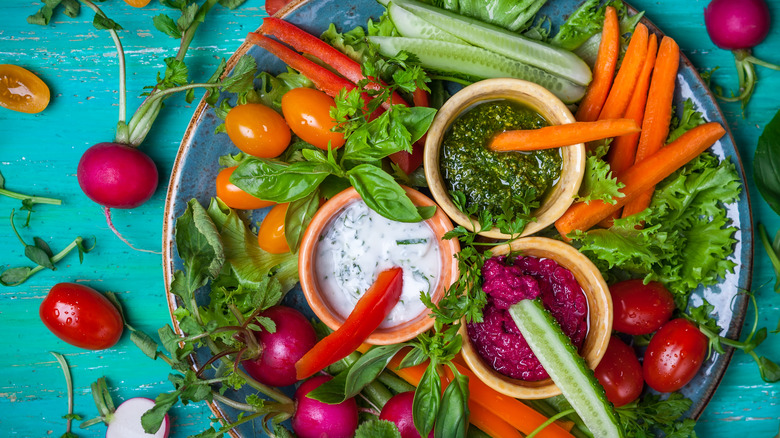For The Best Veggie Platter, Freshness Matters The Most
A vegetable platter, also called a crudité platter, is a stunning array of vibrant produce, appealingly arranged and typically huddled around a delicious dipping sauce. It's a playful and aesthetically pleasing way to present raw vegetables while testing your creativity for which to include and what dips to pair with them. If the vegetables deliver on taste it's a refreshing crowd-pleaser and a great complement for hot or more complex dishes to follow, but to create the best veggie platter, it's the freshness of the produce that matters most.
Buying vegetables that look the most appealing in terms of shape and color is a fair method for hunting down the freshest produce, but sometimes beautiful vegetables can deliver on looks but disappoint in taste. Utilizing other senses, such as smell and touch, is often vital in selecting the most delicious veg because it allows you to properly judge firmness, plumpness, and ripeness to give your platter precisely what it needs.
Using the senses
Carrots, cucumbers, and zucchini should be firm to the touch while possessing a vibrant shade free from spots. Celery should also have a resistant surface, but the addition of bright, crisp leaves is also a great indication of its freshness. Tomatoes (we know they're not scientifically regarded as a vegetable but deserve a mention nonetheless) and lettuce should have a bounce when the skin is pressed.
Next comes the smell test. While smell is not a huge indicator of a vegetable's freshness, some esters and sulfur compounds found within vegetables can be a tell-sign of how old they are. For instance, veggies that are part of the Asteraceae or Compositae family or the lettuce family develop a more pungent smell the older they get. For this, selecting lettuce with a faint aroma is crucial. In terms of other vegetables, avoid any that smell ecstatically sweet or sour.
If you're unable to make it to the store and ordering online is your only option, then ensure that you get the vegetables delivered the morning you intend to create the platter. While there are hacks to keep your vegetables fresher for longer, remember that vegetables start to degrade in quality the moment they are harvested.
Choosing seasonal produce
If the senses test bewilders you, then another keen indicator of fresh produce is choosing what is seasonally available. It's generally regarded that seasonal produce is of a higher quality and tastes better. It's undergone fewer modifications, less transportation, and is harvested more or less precisely when it's meant to be eaten. There is something to be said for quality over quantity, and farmers who prioritize the latter may be trading off taste for numbers.
While you can follow a monthly seasonal produce guide to find which produce is seasonal, remember that varying regions throughout the U.S. will produce different seasonal produce at different times of the year. For instance, spring in the Northeast is likely to see mushrooms in abundance, while spring in the Southwest is likely to peak in corn. Hit up your local greengrocers or farmers' market and ask what's grown locally and when to expect it.
Seasonal produce is also more positive for the environment, decreases your carbon footprint, and is likely full of fewer chemicals and pesticides. Keep the taste and freshness angle of your veggie platter at the forefront of your mind. You can't go wrong if you delve into your senses and what local seasonal produce is available.


